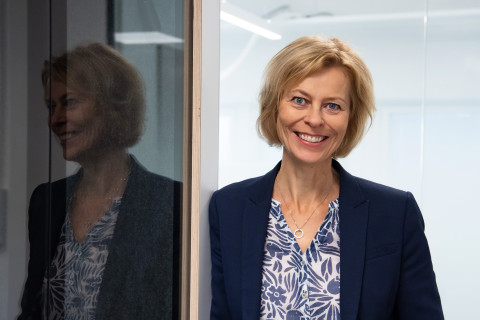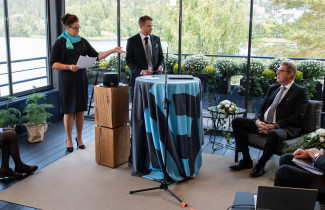Director of Impact Minna Hendolin sees strong national and international partnerships as a goal for the University of Eastern Finland.
“How can world-class research be carried out not only in famous elite universities but also in Finnish ones? It takes long-term commitment, the right kind of networking, and a sufficiently high level of ambition in research and education,” estimates the University of Eastern Finland’s Director of Impact Minna Hendolin, PhD.
“World-class research and innovations emerge from public and private sector competence clusters, and higher education institutions play a key role in the generation of new knowledge. In small countries like Finland, organisations must have strong links to national and global research and innovation ecosystems. For the doors to open, the university must bring something to the table. This is why the level of ambition in our research must be set high enough, and we must build a systematic roadmap to reach it. Without ambition, will, time and courage this cannot be done,” she points out.
Hendolin, who has long worked in expert and leadership roles in research, innovation and finance, shares an example from the early days of her career: back in the 1990s when she was studying transgenic animals at the University of Kuopio, Ian Wilmut, i.e., the leader of the Roslin Institute group that cloned the world-famous sheep Dolly, became an important partner. He was also one of the preliminary examiners of Hendolin’s doctoral dissertation. The research group’s expertise also gave birth to a company that was ultimately listed in the Amsterdam Stock Exchange following a merger.
Impact at the level of society, individuals and economy
The title Director of Impact is still rare in Finnish universities. In a nutshell, the role involves promoting and advocating the university’s interests in national and international research, development and innovation (RDI) activities, and forging new partnerships with business and industry in particular.
Hendolin also points out that impact is included in the strategy of the University of Eastern Finland, and it involves everyone in the academic community.
“The university’s impact arises from the value of its research and education for society, business and industry, and individuals. Typically, impact is seen as collaboration with business and industry, which enhances companies’ competitiveness and creates new businesses and high-skilled jobs. These accumulate for the benefit of society through, for example, tax revenue to pay for the structures and services of the welfare society. Similarly, impact at the individual level is visible, for example, in how university-level education enables different high-skill career paths, increases the general level of education, and increases our understanding of issues affecting ordinary citizens. Societies with a high level of competence also tend to be more stable. It is the hallmark of the welfare state, and higher education institutions play an important role in this, too,” Hendolin says.
Universities’ societal impact and their interaction with business and industry are, year by year, becoming increasingly diverse. The objective of RDI policy in Finland and in the European Union has been to support collaboration between the public and private sectors, and to foster the emergence of diverse ecosystems. When society provides good conditions for universities to operate, it results in high-level research knowledge for decision-makers. This interaction goes both ways.
“Universities have a lot to offer. We generate research-based knowledge to support decision-making when, for example, there is a need to reform legislation, define future strategic priorities, or prepare future government programmes. Research-based knowledge and experts are needed, be it about our future energy solutions or our social welfare and health care services. In addition, we must look after our interests and influence the key decision-makers and officials in society to ensure that the operating environment provides support for the university’s key activities. By doing this, we can build a long-term RDI policy – and a better future for Finland.”
What is the time span society expects to feel the impact of research? Who can say what kind of knowledge we need in 20 years’ time?
Minna Hendolin
Director of Impact
Into the core of Europe’s science policy and partner networks
There is a major gap to bridge when it comes to having national impact versus having impact on an international level. Hendolin’s task is to integrate the University of Eastern Finland into the key European higher education networks and partnerships.
“Looking at the world today, it is clear that now more than ever, we need knowledge and interaction across borders. In science policy, the European University Alliance, for example, is a forum for influencing in which we participate together with other European universities. We must also influence the European Commission’s long-term RDI policy in order to ensure our global competitiveness.”
“How can we involve research conducted at the University of Eastern Finland more strongly in EU partnerships with a view to funding calls? With the support of the Structural Funds and together with our regional partners and companies, we’ve already set many good things in motion. In competitive national and international funding, however, we must step up our game. We will not succeed in that competition unless we recognise companies and strategic partners for collaboration also outside our own regions. This is an issue that stands at the core of my work,” Hendolin says.
The playbook for creating impact addresses a variety of situations. In certain fields, significant international impact can be achieved through the national front. An example of this is the utilisation of health data for research and development, with Finland playing a pioneering role, thanks to long-term investments and collaboration.
For science to have impact, patience and strategic direction are also needed. Innovations emerging from basic research may require persistent efforts and funding before they find a more refined form that will benefit society and its citizens.
“What is the time span society expects to feel the impact of research? Who can say what kind of knowledge we need in 20 years’ time? After all, our vaccines against COVID-19 weren’t invented in a year, but they were developed on the basis of several decades of basic research. Typically, we are talking about long trajectories, and this is precisely where the freedom of research in higher education institutions comes into play,” Hendolin says.
International atmosphere on the home campuses
Hendolin started as Director of Impact at the University of Eastern Finland in early September. During the autumn, she has been visiting the faculties, meeting with researchers and discussing the expectations related to her work.
“I’m excited about this opportunity. If I can bring added value to the region’s vitality and to the competitiveness of the University of Eastern Finland, I’ll be happy. No one can achieve anything alone, the entire network of actors is needed,” she points out.
During her career, Hendolin has held expert and leadership positions in the higher education, private and public sectors alike. Before starting as Director of Impact, she spent 12 years with Tekes/Business Finland, having responsibility for the health and well-being area. Hendolin has been on a leave of absence from Business Finland since 2021 to work as Leading Specialist in the Finnish Innovation Fund Sitra’s Health Data 2030 project, focusing especially on the national health-sector RDI policy, and influencing on the EU level.
“I look forward to making my national and international networks, and my expertise in RDI activities, a natural part of the University of Eastern Finland.”
At the University of Eastern Finland, the circle of Hendolin’s career becomes complete. She is originally from North Karelia and has studied on both the Joensuu and Kuopio campuses. She defended her doctoral dissertation in biochemistry and biotechnology at the A.I. Virtanen Institute for Molecular Sciences in 1998. Now she’s returned to familiar campuses but to a university that is different from what it was in her time.
“The University of Eastern Finland and both of its campuses have evolved radically over these years. The most striking thing is an increase in internationalisation and diversity, which is also something one can see and hear as a happy chatter of foreign languages and encounters between different cultures. I’m also pleased to note the close collaboration between different organisations in the development of the campuses, cities and both regions. One thing that hasn’t changed is the laid-back atmosphere and humour typical of our regions – this is something that can’t be found anywhere else.”






